|
The
1980s saw the emergence of Aboriginal and Torres Strait
Islander textiles influencing non-indigenous designers.
…freelance
curator Anthony (Ace) Bourke staged the first Tiwi
Designs exhibition for them (Adrian Newstead and Louise
Ferrier of Coo-ee Aboriginal Art) at the Hogarth Galleries
in Sydney in 1983. Here six major fashion designers,
including Jenny Kee, Linda Jackson, Katie Pye and
Robert Burton, selected fabric for the Tiwi people
to print, and then made the fabrics up into fashion
garments. (Cochrane, 1992: 329)
|
Linda
Jackson
Linda Jackson is one of Australia's most significant
designer-makers. In the early 1970s Jenny Kee
opened the Flamingo Park frock salon and
included in it Linda Jackson's original creations,
beginning a highly successful and influential
collaboration which lasted ten years. Linda continued
with her own design studio Bush Couture.
The leading Italian fashion writer Anna Piaggi
wrote for Italian Vogue:
The
colours, ecology, flora and fauna and paintings
of the Aborigines were the fountain of inspiration
for one of the most inventive free collections
of fashion we've seen in recent times. (Jackson,
1987, 14)
In
August 1980 Linda travelled to central Australia,
the result was a collection of textiles and garments
inspired by that landscape. In June 1982 she travelled
to Central Australia again and stayed at Utopia
station.
|
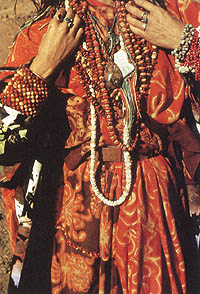
Desert Dress (1982) Utopia
silk ponchos worn with a belt, over a gathered
skirt and hemmed with beans. A bush print
kimono coat is worn over the outfit. Aboriginal
shell and bean jewellery and opal necklaces.
(Jackson, 1987: 106) Photo: Fran Moore. Courtesy:
Linda Jackson. |
|
Some
years ago, I met a group of women from Utopia station,
east of Alice Springs. They had learnt the technique
of batik and were producing unusual lengths of fabric,
interpreting the plants and little animals that lived
around them in the bush.
The
heat of the desert is an ideal place for the batik
technique as the wax is always hot and the fabric
dries quickly in the sun. I used some of these fabrics
in the studio. Later we were invited back to stay
at the station and to meet the other women. It was
a chance also for me to show them the clothes that
I had made with their fabrics and to photograph them
against the desert landscape. (Jackson, 1987: 106-07)
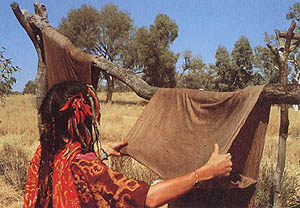
Linda drying mud dyed fabric. (Jackson,
1987: 107) Photo: Fran Moore. Courtesy: Linda Jackson.
|
The
Aborigines' rainbow - ochres, yellow, reds, browns,
white and black - all pigments obtained from the earth.
Another palette for the artist to create from. Painting
and printing with these earthy colours conjures up
the magic of the land and has led me to discover the
arts of the Aboriginal people - their awe for the
natural elements found in the decoration of their
life and art.
(Jackson, 1987: 113)
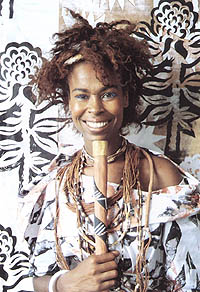
Aborigine Waratah (1987) Using the
Aboriginal colours of black and ochre, a waratah
printed silk taffeta dress and backdrop worn with
Aboriginal string and bark jewellery. (Jackson,
1987: 113) Photo: Linda Jackson. Courtesy: Linda
Jackson. |
During
the last decade Linda has continued her connections
with several Aboriginal communities - Yuendumu, Bathurst
Island, Hermannsburg, Santa Teresa, Oenpelli. She has
also travelled between Alice Springs, Darwin and Broome
and more recently far north Queensland painting and
designing furnishing fabrics for several Port Douglas
resorts.
Jenny
Kee
Jenny Kee was born in Bondi in the late 1940s to a Cantonese
father and Italian/British mother. She made her way
to swinging London in the mid-1960s and made
the most of the creative bohemian atmosphere, landing
a job at the Chelsea Antique market where she sold and
dressed herself in an eye catching mix of ethnic and
retro clothes. On returning to Australia in the early
1970s she decided to set up the Flamingo Park
frock salon in the Strand Arcade selling retro garments
and the work of avant-garde Australian designers including
Linda Jackson and Peter Tully.
Jenny
also began to create her own unique knitwear and printed
cotton and silk garments. Her work drew not only on
her love of Australia's unique natural environment and
in particular its cycles of death and regeneration,
but also on the silhouettes and textiles of traditional
Asian clothing.
Her
work drew on her experience of living in the Blue Mountains
in a home surrounded by native bushland which is frequently
ravaged by fire. From the devastation she has watched
the bush regenerate with a showing of green shoots,
leaves and flowers even more spectacular after their
ordeal. Her waratah and black boy fabric was
inspired by this process, with the rich reds of the
waratahs criss-crossed by the black stalks of the black
boy. Black boy is a colloquial term used for any
species of plant belonging to the genera Xanthorrhoea
and Kingia, thought to resemble a native figure
with a grass skirt holding a spear.
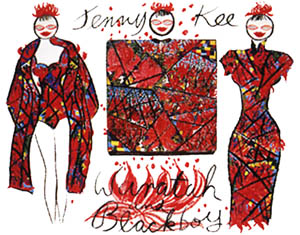
Waratah and black boys
inspired dressing gown, swimming costume and cheungsam
(Powerhouse Museum, 1989: 5) Courtesy: Jenny Kee.
|
A
keen conservationist, Jenny says her approach to both
the land and her work has been influenced by her appreciation
of the deep spiritual bond Aboriginal people have
with the land. In her textile design, Waratah and
black boys, she expresses her own close affinity
to the environment. "Out of the bushfires around
us come the waratah and the black boy - the perfect
symbol of Kali - destruction and regeneration"
is her description of the design.
(Powerhouse Museum, 1992: 35)
|
Rebecca
Paterson
Rebecca Paterson is a Perth based textile and
clothing designer and manufacturer who also lectures
in visual arts and textiles. Paterson is best
known for her innovative and experimental approach
to textile and clothing design and has been involved
in this field for over two decades.
In
1980 Paterson established and designed for Nu
Rotics a Perth based Art/Punk clothes shop.
By 1983 she had moved to Sydney and set up Di
Marzio Line, manufacturing and retailing clothing
with an emphasis on innovative prints. In the
early 1990s she worked as a design and marketing
consultant for Desert Designs in Fremantle. It
was here that she met Megan Salmon and in 1996
they launched their fashion label SpppsssP,
attracting wide acclaim for their showings at
Mercedes Australian Fashion Week in 1998
and 1999. Paterson launched her latest label Breathless
in 2000 with a range of garments featuring dramatic
textiles and bold forms continuing her focus on
process, concept and the designing and making
of clothes that blur the boundaries between art
and fashion.
Paterson
did not take the traditional road into the fashion
industry via training in fashion and textile design.
Rather she studied for a Masters degree in visual
arts and it is this background that led her to
view clothing, textiles and the body from a different
perspective, outside the trend driven mainstream
fashion industry.
|
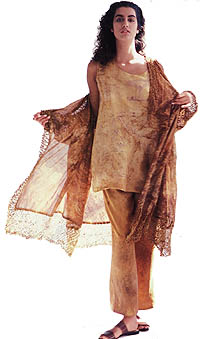 Before outift; pants and skirt
of rust-dyed and screen-printed silk; robe
and shawl of organza with linen netting. Note
the use of knotting to create the linen netting.
Designer: Rebecca Paterson. Courtesy: Breathless.
Photo: courtesy Monty Coles. (Powerhouse Museum,
1989: 57)
Before outift; pants and skirt
of rust-dyed and screen-printed silk; robe
and shawl of organza with linen netting. Note
the use of knotting to create the linen netting.
Designer: Rebecca Paterson. Courtesy: Breathless.
Photo: courtesy Monty Coles. (Powerhouse Museum,
1989: 57) |
|
Her
work draws on an eclectic range of cultural histories
and traditions and she successfully juxtaposes ideas
and forms from such diverse sources as street fashion,
subcultural styles and traditional textiles. Politics,
feminism and spirituality have been recurrent themes
in her work but they are married with her love of the
experimental opportunities contemporary technologies
offer in the creation of new textile forms.
Rebecca
Paterson's loose, flowing outfit, Before, aims
to tell stories of "the nature and history of
Australian women". The tunic's delicate screen-printed
patterns intermingle some of the first white images
of the new land such as maps of Terra Australis with
ancient Aboriginal graphics.
Rebecca
marble-dyes silk in rust to evoke the gritty texture
of a red desert dust storm. Teaching silk screen-printing
in Aboriginal communities has enabled Rebecca to gather
knowledge of the traditional Aboriginal practices
of netting and the extraction of a dye from wattle
puffballs. She has used both these techniques in this
outfit so "the clothes almost smell of the desert".
The
netting is contrasted with a print of lace that recalls
the trappings of European culture and femininity which
early women settlers desperately clung to in the face
of hardship. (Powerhouse Museum, 1989: 57)
Peter
Morrissey
Peter Morrissey began his fashion career with Leona
Edmiston in Sydney, creating a label, Morrissey Edmiston,
that was successful for 14 years. In 1997 they went
their seperate ways and Morrissey's growing retail and
wholesale fashion business has since been bought by
Oreton International.
I
want to make a statement that the cultures of Australia
should come together and celebrate something unique
to us - sexy, individual, cross cultural and rockin'!
(Peter Morrissey, Morrissey Collection Show: Women
and Men 2000)
During the 1999 Fashion Week Morrissey sent out
…T-shirts
that were a hybrid of the Australian and Aboriginal
flags, with the blessing of the latter's originator,
Harold Thomas. The T-shirt went on to be a big seller,
especially among members of the republican movement…
(Epaminondas, 2000: 4)
For
the Mercedes Australian Fashion Week 2000, Peter Morrissey
…looked
to indigenous art and the colours of Uluru for inspiration,
to boomerangs, billabongs and other distinctly Australian
iconography… I was just getting a bit tired of
seeing kids on the street wearing American T-shirts
with words like UCLA and Brooklyn on them. What I'm
trying to do is use great graphics from a country
I love. (Epaminondas, 2000: 4)
|
Theresa Chang, project officer for an Aboriginal
development unit in Darwin arranged for a range
of textiles from Aboriginal and Torres Strait
Islanders to be presented to Peter Morrissey and
Collette Dinnigan. Morrissey was interested and
decided to work with Jacinta Numina Waugh, who
was trained at Nungalinya College in Darwin. Morrissey
chose to reproduce Woman Dreaming, a traditional
design of the Anmatjera people north of Alice
Springs.
|
 Jacinta Numina Waugh and Theresa
Chang, May 2000, Darwin, Northern Territory.
Jacinta Numina Waugh and Theresa
Chang, May 2000, Darwin, Northern Territory.
Courtesy: Morrissey. |
|
Emboldened
by the positive feedback and impressive sales, the
indigenous theme was extended this winter (2000) with
bootcut pants, skirts and tops imprinted with a spectacular
ochre and god design by Aboriginal artist Jacinta
Numina Waugh.
For
summer 2001… Morrissey restyled the Numina print
in three new colourways: hot pink, bright green and
deep brown… and experimented with his own locally
inspired flourishes. Most striking is what the designer
calls his boomerang print… that graces
shirts for men, and shirts, skirts and dresses for
women.
(Epaminondas, 2000: 4)
Morrissey
also used the Numina Waugh design on garments he was
commissioned to design for the Oceania section of the
Arrivals segment for the Opening Ceremony of the 2000
Olympic Games.

Outfit by Peter Morrissey featuring
Jacinta Numina Waugh print pants for the Spring/Summer
2000 Collection chosen for the Grand Marnier/Powerhouse
Museum Fashion of the Year Selection.
Powerhouse Museum Collection. |

A group of garments designed by
Peter Morrissey using a print by Jacinta Numina
Waugh for the Oceania section of the 2000 Sydney
Olympics Opening Ceremony.
Powerhouse Museum Collection. |
Activity
Discuss the issues that may arise when non-indigenous
designers use Aboriginal and Torres Strait Islander
motifs, designs or fabrics in their work?
Is
the use of fabrics printed by Aboriginal and Torres
Strait Islander artists a different issue from the copying
of traditional motifs?
|